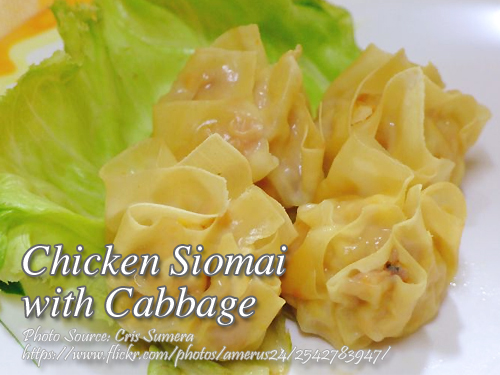This chicken siomai with cabbage siomai dimsum recipe is a healthy siomai because it contains chicken and cabbage. Specially if you are going to use lean chicken meat like the chicken breast because it doesn’t have fat. Cooking this siomai is also very simple.
You just combine all of the filling ingredients and let it stand for 20 minutes in a refrigerator. Then fill each siomai wrapper with about half a teaspoon of filling and wrap. Steam for 20 minutes and there you have it, a nice chicken siomai with cabbage.
Chicken Siomai with Cabbage: A Family Favorite from Malabon
I remember the first time I tasted chicken siomai with cabbage—not in a fancy restaurant, but in my cousin Lanie’s tiny kitchen in Malabon. It was one of those long weekends when the family would gather for no real reason except to eat and catch up. Lanie had just come back from Cebu and proudly said, “Galing ito sa pinsan kong nagtitinda sa palengke. Ito daw ang mabenta nilang siomai, pero chicken version!”
And wow—tender, flavorful, with a bit of crunch from the cabbage. It was simple, light, and definitely different from the usual pork version we grew up with.
Why Chicken Siomai with Cabbage is a Healthier Choice
Traditionally, siomai is made with pork—rich, fatty, and indulgent. But if you’re watching your diet or just want something a little lighter without losing flavor, this chicken and cabbage dumpling is perfect. Using lean ground chicken, especially breast meat, gives you protein minus the grease. And the shredded cabbage? Not just filler—it adds texture and a subtle sweetness that balances out the umami of the soy sauce and oyster sauce in the mix.
My Tita Maricel, who’s now trying to eat “clean,” swears by this version. “Masarap na, healthy pa,” she says while packing a dozen pieces in her baon container after lunch.
The Secret is in the Mix (and the Rest Time!)
When it comes to making chicken siomai with cabbage, the technique is surprisingly straightforward—but there’s one step you shouldn’t skip. After mixing all the ingredients—ground chicken, finely chopped cabbage, spring onions, ginger, breadcrumbs, and seasoning—let it sit in the fridge for 20 minutes.
Why does this work? The rest time helps the flavors meld together. The breadcrumbs absorb excess moisture from the vegetables and meat, giving you a filling that’s firm enough to shape and hold its form inside the wrapper.
My Kuya Nestor once skipped that 20-minute rest because he was in a hurry—and the result? Mushy siomai that fell apart while steaming. Never again.
Wrapping Made Easy, Even for First-Timers
Now, don’t be intimidated by the wrapping part. It might take a few tries to get your siomai looking like those pretty ones in dim sum restaurants, but it doesn’t have to be perfect to be delicious.
Place about half a teaspoon of the chilled filling in the center of a siomai wrapper. Wet the edges slightly with water, then pinch the sides upward, leaving the top exposed. Gently press the bottom on a plate to flatten it so it can stand on its own. It’s okay if they’re not uniform—each one has character, as my Lola used to say.
If you have kids at home, this part is fun to do together. My niece Jamie loves making “baby baskets,” as she calls them, even if hers sometimes topple over in the steamer.
Steaming Tips for Flavor and Aroma
This dish works best in a bamboo steamer. The natural material adds a subtle aroma that metal steamers just can’t replicate. If you don’t have one, it’s okay to use what’s available—but if you ever see a bamboo steamer in Divisoria or Lazada, grab one. Worth it.
Make sure you add enough water to the steamer—around 3 to 4 cups depending on its size. Steam the siomai over medium heat for about 20 minutes, and you’re done. You’ll know they’re ready when the wrappers turn slightly translucent and the tops look glossy.
A Bit of History for the Curious Eater
Siomai, originally a Chinese delicacy, made its way to the Philippines through centuries of trade and migration. Over time, it evolved into something uniquely Filipino—served in carinderias, sold by bike vendors in side streets, and enjoyed as both a snack and a meal.
While pork siomai remains the staple, modern versions like this chicken and cabbage siomai reflect how Filipino food continues to adapt without losing its soul.
Best Dipping Sauce for That Final Kick
You can’t serve siomai without a good sawsawan. Mix soy sauce with calamansi juice and chili for that tangy-spicy bite. My brother Paulo likes to drizzle some toasted garlic chili oil instead. It adds a deeper, smoky heat that really complements the mild flavor of the chicken.
However you mix your sauce, make sure it has a little acidity and heat—it lifts the whole dish.
Final Thoughts
This chicken siomai with cabbage has become a regular in our house. It’s easy, budget-friendly, and lighter than most siomai versions. Whether you’re cooking it for family lunch or freezing a batch for weekday snacks, it always hits the spot.
So if you’ve never made siomai before, don’t worry—this is the recipe to start with. Just like I did in Lanie’s warm kitchen all those years ago, make it with love, share it with the people you care about, and enjoy every bite.
How to Cook Chicken Siomai with Cabbage
Ingredients
- 1/2 kilo ground chicken meat
- 1/4 head cabbage shredded (about 1 and 1/2 cup)
- 1 tbsp salt
- 1 tsp finely chopped spring onions
- 1 Tbsp soy sauce
- 1 Tbsp oyster sauce
- 1 tsp grated ginger
- 4 Tbsp bread crumbs or 2 Tbsp cornstarch
- 1 tsp sesame oil
- Siomai wrappers
Instructions
How to Prepare and Cook Chicken Siomai with Cabbage:
- In a mixing bowl, mix the ground chicken, cabbage, spring onion, ginger, breadcrumbs then add soy sauce, oyster sauce, salt and sesame oil.
- Mix it thoroughly until all the ingredients are well combined and refrigerate for 20 minutes.
- Separate siomai wrappers individually. Place ½ teaspoon in the center of each wrapper; pat the area surrounding the meat with water; bring the sides of the wrapper up over the meat mixture and press the sides together using your fingertips leaving the meat exposed.
- Flatten the bottom part by tapping slowly on a plate for the siomai to stand on its own. Repeat the wrapping procedure until done and ready to cook.
- Arrange the wrapped siomai in a steamer. A bamboo steamer is preferred because it gives a natural distinct flavor than using a stainless steel or aluminum steamer.
- Make sure that the streamer has at least 3 to 4 cups of water for steaming the siomai but it will depend on the size of the steamer.
- Steam for at least 20 minutes and serve.
For the sauce:
- Combine soy sauce, kalamansi juice and chili pepper. You can also use fried chili garlic instead of chili peppers.
Notes
Cooking Tips:
Chill the Filling Before Wrapping
After mixing the chicken, cabbage, and seasonings, let the filling rest in the refrigerator for at least 20 minutes. This helps firm up the texture, making it easier to handle and wrap. It also allows the flavors to blend more evenly for a tastier siomai.Use Thin, Fresh Siomai Wrappers
Fresh wrappers are easier to fold and won’t crack or break during wrapping or steaming. If the wrappers feel dry, lightly steam them for a few seconds or cover with a damp cloth while working. Thin wrappers cook faster and allow the juicy filling to shine through.Don’t Overcrowd the Steamer
Leave a little space between each siomai so the steam can circulate evenly. If they’re too close together, they might stick or cook unevenly. You can also line the steamer with parchment paper or napa cabbage leaves to prevent sticking without blocking the steam.





